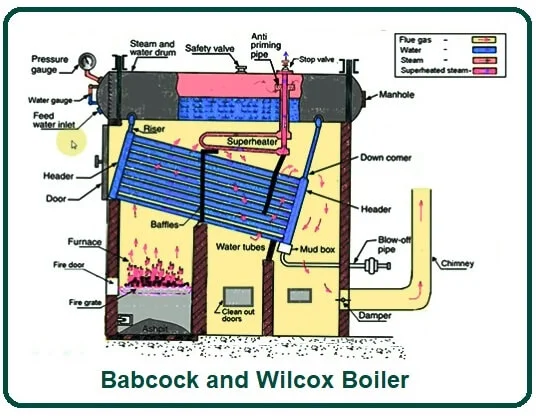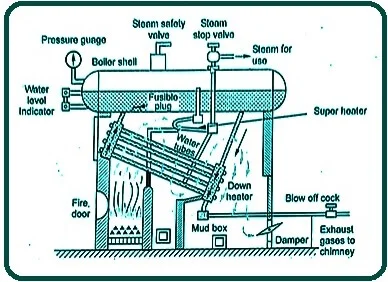Parts of Babcock and Wilcox Boiler | Working of Babcock and Wilcox Boiler | Specifications of Babcock and Wilcox Boiler

Parts of Babcock and Wilcox Boiler | Working of Babcock and Wilcox Boiler | Specifications of Babcock and Wilcox Boiler
What Is Babcock and Wilcox Boiler?


The Babcock and Wilcox boiler is a horizontal, externally fired, water hose, natural circulation boiler. This boiler is named after the individuals who discovered it. It was discovered in 1967 by Herman Babcock and Stephen Wilcox.
This Babcock and Wilcox Boiler is a water tube boiler which is a multi-tubular, high pressure, and externally fired water tube boiler that is used to generate large amounts of steam. This boiler is called a natural circulation boiler because the circulation of water in the boiler is maintained by the current.
This boiler is used to produce high-pressure steam, and with this high pressure, steam is produced in power generation industries. The high-pressure steam produced by this boiler can also be used for other purposes.
Also, Read: Parts of Benson Boiler | Working Principle of Benson Boiler | Construction of Benson Boiler
Parts of Babcock and Wilcox Boiler:
#1. Shell
It has a cylindrical shell. It is made of steel. This shell is filled with water. About 2/3 of the shell is filled with RD water. This shell contains both water & steam.
#2. Supports
The shell is provided with two support to be in a fixed position.
#3. Superheaters
The superheater is used to raise the temperatures of the steam to the required level and to send it to the steam stop valve pipe.
#4. Super Heater Tubes
After removing the moisture content from the steam, the air priming pipe sends the steam to the superheater tube, where the superheater superheats the steam.
#5. Water Pipes or Tubes
There are water pipes under the boiler. These pipes are bent at an angle of 15 degrees, and the diameter of this pipe is about 10 cm. As tilted, the water taps are not completely filled with water, and the coexistence of water and steam can easily separate.
#6. Feed Check Valve
#7. Damper
The Damper is used to regulate the air in the boiler.
#8. Furnace
The furnace of this boiler exists outside the boiler as it is an externally fired boiler. It is placed under the upper header.
#9. Great
Great exists outside the boiler shell. It is usually made of cast iron. Solid fuel (coal) is placed on top of this melt and burnt.
#10. Fire Door
Fire doors are used to ignite solid fuel in the furnace.
#11. Baffles
Baffles are also known as deflectors. They are made of fire-brick. They are used to conserve flue gases so that they do not pass directly. In addition, the area of contact and the time of contact between the flue gases and the water pipe increases, and therefore the efficiency of the boiler increases. Two rashes are used in this boiler.
#12. Anti Priming Pipe
The steam in the shell contains moisture content. So anti priming pipes are used to reduce the moisture content from the steam. This anti priming pipe has a small hole that reduces moisture from steam.
#13. Upper Header and Lower Header
The water pipe is fixed between the upper header & lower header. These water pipes fit over the holes of the upper header and lower header. The upper header & lower header are connected to the shell through the pipe.
The lower headers are present at the rear end of the boiler, & it receives water from the back end of the shell and transfers it to the water tube.
The upper header is present at the front end of the boiler. Its main function is to transfer the mixture of steam and water into the shell.
#14. Mud Box
Below the lower header, a mud box is present. This earthen box is used to collect foreign particles or sludge from water coming from a cylindrical shell through a water pipe. This sludge can be removed later.
#15. Man Hole
A manhole is an entry for a person to enter a boiler and clean the boiler inside or replace its parts at the time of its maintenance. This is sometimes referred to as an inspection hole.
#16. Blow Off Pipe
Blow-off pipes are used to remove soil particles from the soil box and excess water from the boiler.
Also, Read: Parts of Cornish Boiler | Working Principle of Cornish Boiler | Construction of Cornish Boiler
Working of Babcock and Wilcox Boiler:

First, the boiler shell is fed with water using a feed pump. As the water feeds into the shell of the boiler, water starts to move from the boiler shell to the water tubes. After that, when the water tube is filled with water, the coal is lit on the top of the furnace, which produces hot gases.
These hot gases pass over the water pipe, and the cyclic plates will reflect the hot gases, and these gases will pass through the top or bottom of the water tubes or at a zig-zag speed. After passing over the water pipe, hot gases exit the boiler through a passage.
Since hot gases continuously flow from the top of the water pipe, the hot gases cause the water pipes to heat up, and the water inside the water pipe begins to heat evenly. When the water in the water pipe heats up, the water density decreases, and this causes the water to flow upward towards the upper header.
As the water in the water pipe moves upwards, its density steadily decreases, and we find a mixture of water and vapor in the upper header. Since the water taps are bent, the water taps are not completely filled with water, and water tubes coexist and can be easily separated.
This mixture of water and vapor reaches the cylindrical shell from the upper header and converges on the upper side of the boiler shell. After reaching the shell, a mixture of water and vapor enters the anti-priming pipe.
An anti priming pipe will reduce the moisture of wet steam. After that, the anti-priming pipe supplies moisture-free or dry steam to the superheater. This steam will travel into the superheater tube and, due to the flue gases, superheat and convert to superhit steam.
After converting to superheated steam, it reaches the stop valve pipe, and this stop valve is connected to the pipe stop valve where the superheated steam stops. These stop valves can be opened or closed as required, and steam can be provided to the required system. This steam is usually sent to a steam turbine to generate electricity.
Specifications of Babcock and Wilcox Boiler:
Specifications of Babcock and Wilcox boilers are as follows.
- The diameter of drums = 1.22 to 1.83 m.
- Length = 6.096 to 9.144 m.
- Size of super-heater tubes = 3.84 to 5.71 cm.
- Steaming Capacity = 40000 kg / hr (max).
- The size of water tubes is 7.62 to 10.16 cm.
- Efficiency = 60% to 80%.
- Working pressure = 140 bar (max).
Also, Read: Parts of Lamont Boiler | What Is Lamont Boiler? | Working of Lamont Boiler | Construction of Lamont Boiler
Advantages of Babcock and Wilcox Boiler:
The advantages of Babcock and Wilcox boilers are as follows.
- Generate steam at high pressure and rate high (140 bar and 40000 kg/hr)
- For a given output, it occupies less space.
- Parts are accessible for cleaning, inspection, and repair.
- Parts can be disassembled and easily carried.
- Due to the heating surface, the fuel is completely burnt.
Also, Read: Design of Knuckle Joint | What Is a Knuckle Joint? | Failure of Knuckle Joint
Disadvantages of Babcock and Wilcox Boiler:
These are some of the disadvantages of the Baybuck and Wilcox boilers:
- It is less suitable for impure and sedimentary waters, as a small deposition of the scale may cause overheating and rupture of tubes. Therefore, water treatment is essential for water hose boilers.
- Failure of the feed water supply even for a short period of time is responsible for overheating the boiler. Therefore the water level should be watched very carefully during the operation of the water tube boiler.
- Maintenance costs are high.
Applications of Babcock and Wilcox Boiler:
The applications of Babcock and Wilcox boilers are as follows.
- In the power generation industries, Babcock and Wilcox’s boilers are used to produce high-pressure steam.
- The steam generates used to produce large amounts of electricity.
Frequently Asked Questions (FAQ)
Babcock Wilcox Boilers
The Babcock & Wilcox boiler is a stationary water tube boiler. It has a steam-water drum. A small tube connects the steam water drum to the uptake header and down header, as shown in the figure. A mud box is equipped with each down space header, and the collected mud is removed.
Babcock and Wilcox Boiler
In 1867, in Providence, Rhode Island, residents Stephen Wilcox and his partner George Herman Babcock patented the Babcock & Wilcox Non-Explosive Boiler, which used water-filled tubes and de-nucleate boiling to generate steam more safely than either under-fire or fire-tube boilers.+
Babcock & Wilcox Boiler
The CFB boiler is ideal for high sulfur and high ash fuels and various waste fuels, wood, biomass, gob and culm. Learn More.
